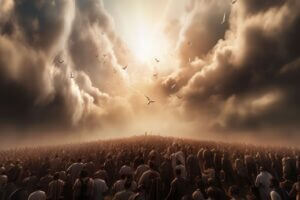This weekend, March 23-24, Jews around the world will celebrate Purim. This annual cultural event memorializes events recorded in the Old Testament book or scroll of Esther when the Jewish people living in the greater Persian Empire were saved from extermination. It is a study of the survival of God’s people amid life-threatening hostility.
The biblical story takes place after the extended and final siege of Jerusalem and the destruction of Solomon’s temple by the Babylonian King Nebuchadnezzar between 589 and 587 B.C. The subsequent deportation forced thousands of people from the kingdom of Judah to Babylon and beyond for seven decades.
The book takes its name from the beautiful, orphaned Hebrew girl who became the queen of the Persian king Ahasuerus (also identified as Xerxes I). In the fifth century B.C., he ruled for 20 years over 127 provinces from India to Ethiopia (Esther 1:1, 8:9).
Hadassah and Mordecai
The biblical story takes place over four years, as Esther (her Hebrew name was Hadassah) comes on the scene and is used by God to influence the king and save her people. Orphaned, Esther was raised by Mordecai, an older cousin who treated her as his own daughter (2:7).
Strong-willed Queen Vashti disrespected King Ahasuerus and rejected his command to come before him when he called. His advisers saw such public rebellion as not being a good example for his vast kingdom. They recommended he take a type of executive action and declare a law of the Medes and Persians that Vashti be replaced and her royal position be given “to another who is better (1:19b, ESV).
This suggestion pleased the king and his royal officials and letters were sent to all the king’s provinces, each in its own language and writing, affirming that “every man be master of his own household and speak according to the language of his people” (1:22b).
Mordecai was the great-grandson of Kish, who was of the clan of patriarch Isaac’s grandson Benjamin (2:5). We’ll discuss that significance in a moment, but notice that Mordecai urged Esther not to reveal information about her family tree (2:10).
Esther continued the 12-month beauty program for aspiring candidates to replace the queen (2:12-14). Finally, we are told: “The king loved Esther more than all the women, and she won grace and favor in his sight more than all the virgins, so that he set the royal crown on her head and made her queen instead of Vashti” (2:17).
Breaking News. Spirit-Filled Stories. Subscribe to Charisma on YouTube now!
Haman and Ahasuerus
While Esther was queen, a wicked man named Haman was promoted to a position we might think of as prime minister. In this advanced role, the king’s servants and other leaders in the kingdom and at the king’s gate “bowed and paid homage to Haman,” as the king commanded. “But Mordecai did not bow or pay homage” (3:1-2).
Word of this disrespect finally reached Haman, including the news that Mordecai had told some of the other servants that “he was a Jew” (3:4). Cousin Mordechai may have been the first person in history to be called a “Jew”? Before then, Jews were called “Hebrews” or “Israelites.”
When Haman saw this disrespect with his own eyes, he was “filled with fury” (3:5). But his wrath was not just for Mordecai. “Haman sought to destroy all the Jews, the people of Mordecai, throughout the whole kingdom of Ahasuerus” (3:6b).
Antisemitism swept over Haman, and he wanted to eliminate not just Mordecai, but the “people of Mordecai” throughout all 127 provinces of the Medes and Persian Empire. This was similar to the way Hitler wanted to eliminate Europe’s “Jew problem” by exterminating the entire Jewish population.
Haman plotted to kill all the Jewish people, and, through a series of deceptions, was granted permission by the king to do so (3:8-11). Ahasuerus gave his signet ring to Haman as a sign of delegating his full royal authority.
Remember Mordecai’s and Esther’s heritage? Verse 10 identifies Haman as “the son of Hammedatha the Agagite, the enemy of the Jews.” Agag was the Amalekite king whom Saul conquered in 1 Samuel 15.
The Amalekites resisted the Israelites during the time of the exodus and were the first nation to attack the Jewish people unprovoked as they traveled from Egypt. Haman was an Agagite and Amalekite by heritage and would have likely grown up hating the Hebrews, God’s people. His plot to destroy all of them throughout the Medo-Persian Empire is not surprising.
The story of Esther shows how Mordechai and Esther faced and defeated this ancient spirit of enmity. However, the spirit of Amalek continues against God’s people, the Jews, to this day. It may also battle born-again Christians, as God’s “dearly loved children” (Eph. 5:1b; NIV) of His new covenant.
Hamas and Hezbollah
The Amalekites symbolized the relentless and unprovoked attacks on God’s people. The modern terrorist organizations of Hamas (in Gaza) and Hezbollah (in Lebanon) are manifesting like the spirit of Amalek. They were formidable foes and remain perennial enemies of God’s people, the Jews, today.
These real-world descendants of Esau and his grandson Amalek manifest with constant testing as spiritual forces of Satan. Like the devil, they want to kill, maim and destroy. However, our God is greater! Israel is still the apple of God’s eye (Zech. 2:8).
The same may be applied spiritually. Spiritual warfare is based on the finished work of the cross of Jesus and the promised empowerment of the Holy Spirit. We may face the “spirit of Amalek,” but we can claim the truth that “greater is He that is in us than he that is in the world” (see 1 John 4:4).
Don’t Forget to Forget
In Deuteronomy 25:17-19 (ESV), the Israelites were instructed to “Remember what Amalek did to you on the way as you came out of Egypt … you shall blot out the memory of Amalek from under heaven; you shall not forget.” It is almost as if God is saying “Don’t forget to forget.”
Mordecai established a yearly celebration of Purim, from the word pur, which meant casting of a lot, which Haman used to determine the day and month for the planned annihilation of the Jews. This was, for the Jews, to be a time of “feasting and gladness, days for sending gifts of food to one another and gifts to the poor … throughout every generation … that these days of Purim should never fall into disuse among the Jews, nor should the commemoration of these days cease among their descendants” (Esth. 9:21-32).
When our Jewish and Messianic friends celebrate Purim next weekend, they will dress up as characters in Esther’s story, and someone will retell it very dramatically. The children listen to the familiar story over and over because they practice banging and spinning noisemakers called “gragers” or making loud hisses whenever the name of Haman is read. It’s their way of blotting out the remembrance of Haman and his evil Amalekite spirit.{eoa}
Join Charisma Magazine Online to follow everything the Holy Spirit is doing around the world!
Gary Curtis served for 27 years as part of the pastoral staff of The Church on The Way, the First Foursquare Church of Van Nuys, California. Since retirement in 2016, he has continued to blog at worshipontheway.wordpress.com. Gary and his wife live in Southern California and have two married daughters and five grandchildren.
See an error in this article?
To contact us or to submit an article






















